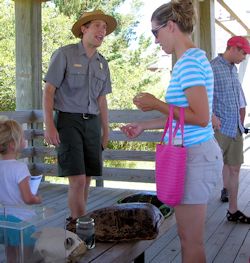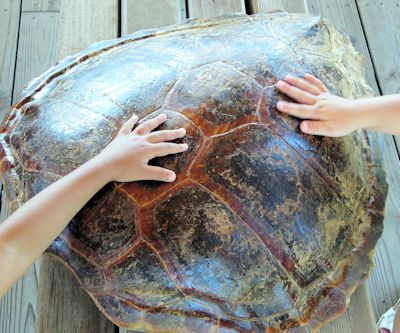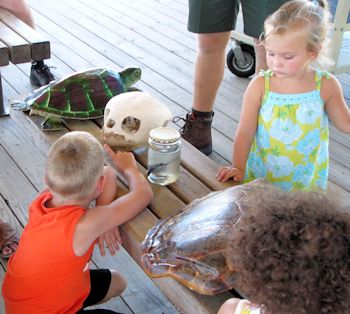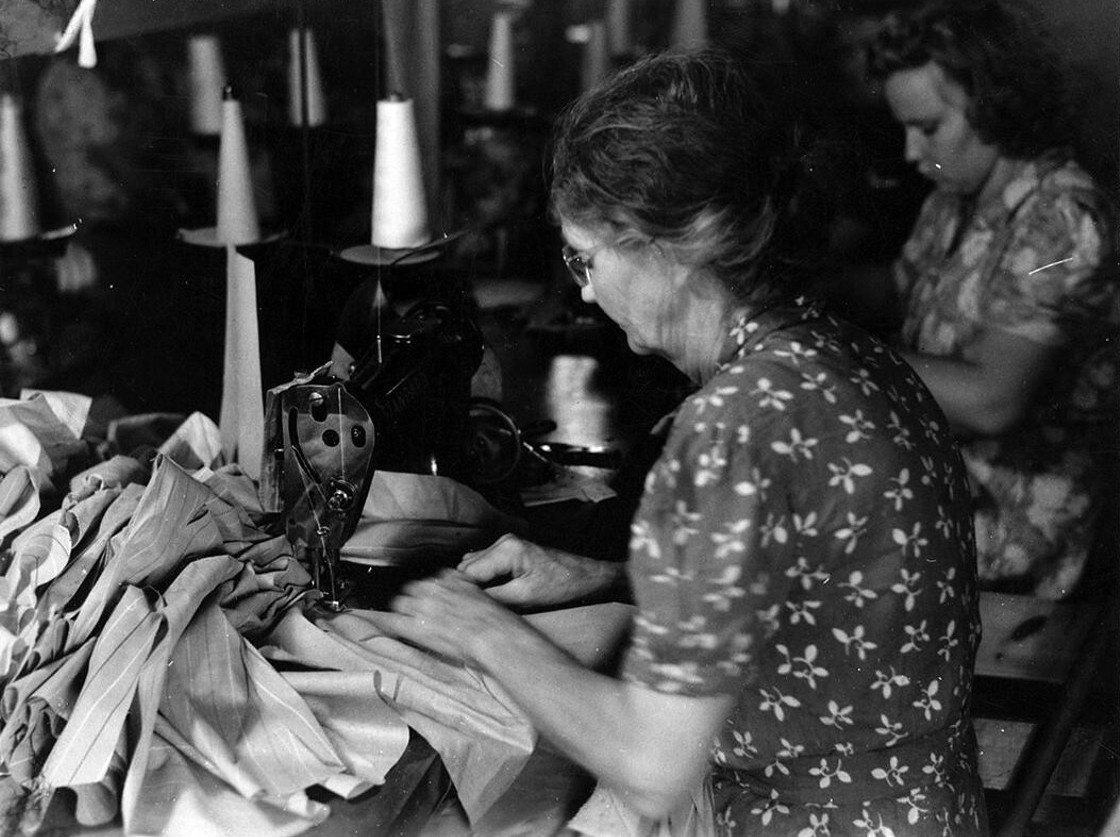 Ranger Abe Hartsell talks to visitors at Cape Hatteras National Seashore about sea turtles. Photo: Corinne Saunders |
BUXTON – Ranger Abe laid out the display items on a wooden bench in the pavilion of the Cape Hatteras National Seashore’s Hatteras Island Visitors Center: a large loggerhead sea turtle shell, a baby sea turtle preserved in a jar, a sea turtle skull and a transparent, cube-shaped container of Ping-Pong balls.
About 45 people – from Pennsylvania, Illinois, Ohio and various parts of North Carolina – gathered recently in the welcoming shade to listen to Park Ranger Abe Hartsell talk about one of our coast’s most beloved visitors, sea turtles.
Supporter Spotlight
The seashore will offer the free 30-minute program every Monday and Friday at 11 a.m. until Sept. 2.
Ranger Abe noted that a sea turtle lays 80 to 100 eggs, which incubate for about 60 days before the babies hatch and “scurry toward the ocean.”
The sea turtles then go through “the lost years” in the open sea—so-named because it’s hard to track them. They eat, get bigger and find a mate, Hartsell said.
“Their ultimate goal is to make it back to the beach to lay eggs of their own,” he said.
Hartsell led an interactive game to demonstrate the obstacles sea turtles face throughout their lives. Everyone drew numbered Ping-Pong balls from the container.
Supporter Spotlight
“If the mother digs too deep, it will be too cold, and the eggs don’t develop properly,” he said. “If she digs too thin, it could actually fry the eggs. If you drew a number eight, you didn’t hatch.”
Participants returned No. 8 balls to the plastic container.
“Sea turtles like to come out at night,” he said, since sand gets too hot during the day.
They need to make it to the ocean to find food, and use the moonlight reflecting off the ocean to guide them. Artificial lighting such as streetlights can lead them in the wrong direction,” Hartsell said. “If you drew a number seven, you’re getting confused. “Put your ping-pong balls back.”
Some studies show that half of the hatchlings will head the wrong way, he added.
Predators on the beach could also intercept turtles trying to reach the ocean. He asked what predators hunt them.
 Two small hands feel the leathery toughness of a turtle shell. Photo: Corinne Saunders |
“Seagulls?” guessed a young boy.
“Birds don’t really hunt at night,” Hartsell replied, noting that foxes, raccoons and crabs do.
Raccoons can bite right through the soft shells of the newly hatched, and “ghost crabs love baby sea turtles,” he said, holding up an enlarged picture of a ghost crab.
“Their favorite part is the brain,” he said. “They will kill just to eat the brains. They’re like the zombies of the beach at night. Unfortunately, some of us got our brains eaten.”
No. 6 balls were returned.
“Other predators are waiting in the ocean to gobble us up,” he continued. “We’re slow swimmers. If you drew a number nine, you got eaten by a fish.”
He congratulated those still holding balls at this point, noting the quickly filling container in front of him. But the game had not concluded.
“It’s starting to get light out,” he said. “We have some birds waiting to eat us. Pelicans dive right down and scoop us up. We have fish coming from below, birds from above; it’s pretty tough.”
The remaining sea turtles in the audience were allowed to grow bigger. They soon learned that size, however, is not always advantageous.
“Sometimes when you get too big you get stuck,” he said, explaining how larger turtles can get caught in fishing lines and fishing nets.
Sea turtles breathe oxygen, so those stuck in nets and unable to make it to the surface will drown.
More balls were returned.
“Some of us were caught on accident; some were caught on purpose,” he stated, holding up the loggerhead shell.
He explained that while some cultures people eat turtles and some poachers take more than fishing limits allow, the shell is what poachers are typically after, for jewelry-making.
“If you drew a number three, you’re dangling from someone’s ears.”
Hartsell then held up a glass jar with a translucent form swirling in its water. “Sea turtles love to eat jellyfish. So this is a plastic bag; it looks like a jellyfish.”
Plastic bags and other trash can suffocate them outright, or build up in their intestine over time. Since they can’t pass plastic, it eventually kills them, he said.
 Children touch skulls and shells and inspect a baby turtle preserved in a jar. Photo: Corinne Saunders. |
Also like humans, sea turtles can get sick from tumors.
The game concluded with only two people still holding ping-pong balls.
“We started with 100,” Hartsell noted. “Only two made it. I’ve been told one in 100 is the sea turtle success rate.”
If participants see a turtle nest, he said to think about the one percent that will survive to lay eggs of their own.
“It’s like winning the lottery for them,” he said.
The staff at Cape Hatteras National Seashore has monitored sea turtle activity in the park since 1987.
Loggerheads and green sea turtles are classified as threatened under federal law. Leatherbacks, Kemp’s Ridleys and hawksbills are listed as endangered.
The Outer Banks is the extreme northern nesting limit for four of the five species. The hawksbills nesting range is farther south.
Of the 222 documented turtle nests at the seashore in 2012, 219 were loggerhead nests, according to park data.
For the first time ever, the National Park Service this summer is offering sea turtle nest excavation programs. Two to three days after a natural hatch, a press release explained, biologists dig up the nest, count eggshells and collect unhatched eggs for research. Live hatchlings are sometimes found, too.
A park ranger will simultaneously present a program on sea turtles.
Notice of programs will usually occur a day in advance, so those interested in excavation programs are encouraged to regularly call the program hotline at 252-475-9629.







